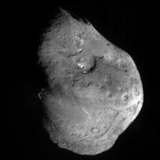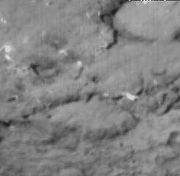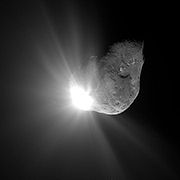
9P/Tempel
Encyclopedia
Tempel 1 is a periodic comet discovered by Wilhelm Tempel in 1867. It currently completes an orbit of the Sun
every 5.5 years. Tempel 1 was the target of the Deep Impact space mission, which photographed a deliberate high-speed impact upon the comet in 2005. It was re-visited by the Stardust
spacecraft on February 15, 2011.
. At the time of discovery, it approached perihelion once every 5.68 years (designations 9P/1867 G1 and 1867 II). It was subsequently observed in 1873 (9P/1873 G1, 1873 I, 1873a) and in 1879 (1879 III, 1879b).
However, photographic attempts during 1898 and 1905 failed to recover the comet, and astronomers surmised that it had disintegrated
. In fact, its orbit had changed. Tempel 1's orbit occasionally brings it sufficiently close to Jupiter
to be altered, with a consequent change in the comet's orbital period. This occurred in 1881 (closest approach to Jupiter of 0.55 AU), lengthening the orbital period to 6.5 years. Perihelion also changed, increasing by 50 million kilometres, rendering the comet far less visible from Earth
.
 Tempel 1 was rediscovered 13 orbits later in 1967 (as 9P/1967 L1, 1966 VII), after British astronomer Brian G. Marsden
Tempel 1 was rediscovered 13 orbits later in 1967 (as 9P/1967 L1, 1966 VII), after British astronomer Brian G. Marsden
performed precise calculations of the comet's orbit that took into account Jupiter's perturbations
. Marsden found that further close approaches to Jupiter in 1941 (0.41 AU) and 1953 (0.77 AU) had decreased both the perihelion distance and the orbital period to values smaller than when the comet was initially discovered (5.84 and 5.55 years, respectively). These approaches moved Tempel 1 into its present libration
around the 1:2 resonance with Jupiter. Despite an unfavorable 1967 return, Elizabeth Roemer
of the Catalina Observatory took several photographs. Initial inspection revealed nothing, but in late 1968 she found a June 8, 1967 exposure (Tempel 1 had passed perihelion in January) that held the image of an 18th magnitude diffuse object very close to where Marsden had predicted the comet to be. Unfortunately, a single image does not allow an orbit computation, so the next return had to be awaited.
Roemer and L. M. Vaughn recovered the comet on January 11, 1972, from Steward Observatory
(9P/1972 A1, 1972 V, 1972a). The comet became widely observed, reached a maximum brightness of magnitude 11 during May, and was last seen on July 10. Since that time the comet has been seen at every apparition, in 1978 (1978 II, 1977i), 1983 (1983 XI, 1982j), 1989 (1989 I, 1987e1), 1994 (1994 XIUX, 1993c), 2000 and 2005. Its current orbital period is 5.515 years.
since discovery has been 11, far below naked-eye visibility. Its nucleus measures 7.6×4.9 km
. Measurements taken by the Hubble Space Telescope
in visible light and the Spitzer Space Telescope
in infrared light suggest a low albedo
of only 4%.http://deepimpact.umd.edu/science/pubs/bioast_meech.pdf A two-day rotation rate was also determined.http://www.newswise.com/articles/space-telescopes-sharpen-view-of-comet-for-um-led-deep-impact
 On 4 July 2005 at 05:52 UTC
On 4 July 2005 at 05:52 UTC
(01:52 EDT), Tempel 1 was deliberately struck by one component of the NASA
Deep Impact probe, one day before perihelion. The impact was photographed by the other component of the probe, which recorded a bright spray from the impact site. The impact was also observed by earthbound and space telescopes, which recorded a brightening of several magnitudes.
The crater
that formed was not visible to Deep Impact due to the cloud of dust raised by the impact, but was estimated to be between 100 and 250 meters in diameter and 30 meters deep. The probe's spectrometer instrument detected dust particles finer than human hair, and discovered the presence of silicates, carbonates, smectite, metal sulfides (like fool's gold), amorphous carbon
and polycyclic aromatic hydrocarbons.
, which had studied Comet Wild 2 in 2004. Stardust was placed into a new orbit so that it approached Tempel 1. It passed at a distance of approximately 181 km (112.5 mi) on February 15, 2011, 04:42 UTC. This was the first time that a comet was visited twice.
On February 15, NASA scientists identified the crater formed by Deep Impact in images from Stardust. The crater is estimated to be 150 m (492.1 ft) in diameter, and has a bright mound in the center likely created when material from the impact fell back into the crater. The geometry of the flyby allowed investigators to obtain considerably more three dimensional information about the nucleus from stereo pairs of images than during Deep Impacts encounter. Scientists were able to quickly spot locations where an elevated flow-like formation of icy
material on the comet's surface receded due to sublimation between encounters.
and outgassing
. Tempel 1 will pass within 0.04 AU (5.9 million kilometres) of the dwarf planet
Ceres on November 11, 2011. Then, as a Jupiter-family comet, it will spend years interacting with the giant planet
Jupiter, finally passing within 0.02 AU (3 million kilometres) of Mars
on October 17, 2183.
Sun
The Sun is the star at the center of the Solar System. It is almost perfectly spherical and consists of hot plasma interwoven with magnetic fields...
every 5.5 years. Tempel 1 was the target of the Deep Impact space mission, which photographed a deliberate high-speed impact upon the comet in 2005. It was re-visited by the Stardust
Stardust (spacecraft)
Stardust is a 300-kilogram robotic space probe launched by NASA on February 7, 1999 to study the asteroid 5535 Annefrank and collect samples from the coma of comet Wild 2. The primary mission was completed January 15, 2006, when the sample return capsule returned to Earth...
spacecraft on February 15, 2011.
Discovery and orbital history
Tempel 1 was discovered on April 3, 1867, by Wilhelm Tempel, an astronomer working in MarseilleMarseille
Marseille , known in antiquity as Massalia , is the second largest city in France, after Paris, with a population of 852,395 within its administrative limits on a land area of . The urban area of Marseille extends beyond the city limits with a population of over 1,420,000 on an area of...
. At the time of discovery, it approached perihelion once every 5.68 years (designations 9P/1867 G1 and 1867 II). It was subsequently observed in 1873 (9P/1873 G1, 1873 I, 1873a) and in 1879 (1879 III, 1879b).
However, photographic attempts during 1898 and 1905 failed to recover the comet, and astronomers surmised that it had disintegrated
Lost comet
A lost comet is a previously discovered comet that has been missed at its most recent perihelion passage, generally because there is not enough data to reliably calculate the comet's orbit and predict its location....
. In fact, its orbit had changed. Tempel 1's orbit occasionally brings it sufficiently close to Jupiter
Jupiter
Jupiter is the fifth planet from the Sun and the largest planet within the Solar System. It is a gas giant with mass one-thousandth that of the Sun but is two and a half times the mass of all the other planets in our Solar System combined. Jupiter is classified as a gas giant along with Saturn,...
to be altered, with a consequent change in the comet's orbital period. This occurred in 1881 (closest approach to Jupiter of 0.55 AU), lengthening the orbital period to 6.5 years. Perihelion also changed, increasing by 50 million kilometres, rendering the comet far less visible from Earth
Earth
Earth is the third planet from the Sun, and the densest and fifth-largest of the eight planets in the Solar System. It is also the largest of the Solar System's four terrestrial planets...
.

Brian G. Marsden
Brian Geoffrey Marsden was a British astronomer born in Cambridge, England, and educated at The Perse School in Cambridge, New College, Oxford and Yale University. Dr...
performed precise calculations of the comet's orbit that took into account Jupiter's perturbations
Perturbation (astronomy)
Perturbation is a term used in astronomy in connection with descriptions of the complex motion of a massive body which is subject to appreciable gravitational effects from more than one other massive body....
. Marsden found that further close approaches to Jupiter in 1941 (0.41 AU) and 1953 (0.77 AU) had decreased both the perihelion distance and the orbital period to values smaller than when the comet was initially discovered (5.84 and 5.55 years, respectively). These approaches moved Tempel 1 into its present libration
Libration
In astronomy, libration is an oscillating motion of orbiting bodies relative to each other, notably including the motion of the Moon relative to Earth, or of Trojan asteroids relative to planets.-Lunar libration:...
around the 1:2 resonance with Jupiter. Despite an unfavorable 1967 return, Elizabeth Roemer
Elizabeth Roemer
Elizabeth Roemer is an American astronomer whose research interests center on comets and asteroids.She discovered the asteroids 1930 Lucifer and 1983 Bok...
of the Catalina Observatory took several photographs. Initial inspection revealed nothing, but in late 1968 she found a June 8, 1967 exposure (Tempel 1 had passed perihelion in January) that held the image of an 18th magnitude diffuse object very close to where Marsden had predicted the comet to be. Unfortunately, a single image does not allow an orbit computation, so the next return had to be awaited.
Roemer and L. M. Vaughn recovered the comet on January 11, 1972, from Steward Observatory
Steward Observatory
The University of Arizona's Steward Observatorys main office is located on the University's campus and is closely tied to the Department of Astronomy. Established in 1916 by its first director, Andrew Ellicott Douglass, and a $60,000 bequest made by Lavinia Steward in memory of her late husband...
(9P/1972 A1, 1972 V, 1972a). The comet became widely observed, reached a maximum brightness of magnitude 11 during May, and was last seen on July 10. Since that time the comet has been seen at every apparition, in 1978 (1978 II, 1977i), 1983 (1983 XI, 1982j), 1989 (1989 I, 1987e1), 1994 (1994 XIUX, 1993c), 2000 and 2005. Its current orbital period is 5.515 years.
Physical characteristics
Tempel 1 is not a bright comet; its brightest apparent magnitudeApparent magnitude
The apparent magnitude of a celestial body is a measure of its brightness as seen by an observer on Earth, adjusted to the value it would have in the absence of the atmosphere...
since discovery has been 11, far below naked-eye visibility. Its nucleus measures 7.6×4.9 km
Kilometre
The kilometre is a unit of length in the metric system, equal to one thousand metres and is therefore exactly equal to the distance travelled by light in free space in of a second...
. Measurements taken by the Hubble Space Telescope
Hubble Space Telescope
The Hubble Space Telescope is a space telescope that was carried into orbit by a Space Shuttle in 1990 and remains in operation. A 2.4 meter aperture telescope in low Earth orbit, Hubble's four main instruments observe in the near ultraviolet, visible, and near infrared...
in visible light and the Spitzer Space Telescope
Spitzer Space Telescope
The Spitzer Space Telescope , formerly the Space Infrared Telescope Facility is an infrared space observatory launched in 2003...
in infrared light suggest a low albedo
Albedo
Albedo , or reflection coefficient, is the diffuse reflectivity or reflecting power of a surface. It is defined as the ratio of reflected radiation from the surface to incident radiation upon it...
of only 4%.http://deepimpact.umd.edu/science/pubs/bioast_meech.pdf A two-day rotation rate was also determined.http://www.newswise.com/articles/space-telescopes-sharpen-view-of-comet-for-um-led-deep-impact
Deep Impact space mission

Coordinated Universal Time
Coordinated Universal Time is the primary time standard by which the world regulates clocks and time. It is one of several closely related successors to Greenwich Mean Time. Computer servers, online services and other entities that rely on having a universally accepted time use UTC for that purpose...
(01:52 EDT), Tempel 1 was deliberately struck by one component of the NASA
NASA
The National Aeronautics and Space Administration is the agency of the United States government that is responsible for the nation's civilian space program and for aeronautics and aerospace research...
Deep Impact probe, one day before perihelion. The impact was photographed by the other component of the probe, which recorded a bright spray from the impact site. The impact was also observed by earthbound and space telescopes, which recorded a brightening of several magnitudes.
The crater
Impact crater
In the broadest sense, the term impact crater can be applied to any depression, natural or manmade, resulting from the high velocity impact of a projectile with a larger body...
that formed was not visible to Deep Impact due to the cloud of dust raised by the impact, but was estimated to be between 100 and 250 meters in diameter and 30 meters deep. The probe's spectrometer instrument detected dust particles finer than human hair, and discovered the presence of silicates, carbonates, smectite, metal sulfides (like fool's gold), amorphous carbon
Amorphous carbon
Amorphous carbon or free, reactive carbon, is an allotrope of carbon that does not have any crystalline structure. As with all glassy materials, some short-range order can be observed...
and polycyclic aromatic hydrocarbons.
NExT mission
In part because the crater formed during the Deep Impact collision could not be imaged during the initial flyby, on 3 July 2007, NASA approved the New Exploration of Tempel 1 (or NExT) mission. The low-cost mission utilized the already existing Stardust spacecraftStardust (spacecraft)
Stardust is a 300-kilogram robotic space probe launched by NASA on February 7, 1999 to study the asteroid 5535 Annefrank and collect samples from the coma of comet Wild 2. The primary mission was completed January 15, 2006, when the sample return capsule returned to Earth...
, which had studied Comet Wild 2 in 2004. Stardust was placed into a new orbit so that it approached Tempel 1. It passed at a distance of approximately 181 km (112.5 mi) on February 15, 2011, 04:42 UTC. This was the first time that a comet was visited twice.
On February 15, NASA scientists identified the crater formed by Deep Impact in images from Stardust. The crater is estimated to be 150 m (492.1 ft) in diameter, and has a bright mound in the center likely created when material from the impact fell back into the crater. The geometry of the flyby allowed investigators to obtain considerably more three dimensional information about the nucleus from stereo pairs of images than during Deep Impacts encounter. Scientists were able to quickly spot locations where an elevated flow-like formation of icy
Volatiles
In planetary science, volatiles are that group of chemical elements and chemical compounds with low boiling points that are associated with a planet's or moon's crust and/or atmosphere. Examples include nitrogen, water, carbon dioxide, ammonia, hydrogen, and methane, all compounds of C, H, O...
material on the comet's surface receded due to sublimation between encounters.
Close approaches
Comets are in unstable orbits that evolve over time due to perturbationsPerturbation (astronomy)
Perturbation is a term used in astronomy in connection with descriptions of the complex motion of a massive body which is subject to appreciable gravitational effects from more than one other massive body....
and outgassing
Outgassing
Outgassing is the release of a gas that was dissolved, trapped, frozen or absorbed in some material. As an example, research has shown how the concentration of carbon dioxide in the Earth's atmosphere has sometimes been linked to ocean outgassing...
. Tempel 1 will pass within 0.04 AU (5.9 million kilometres) of the dwarf planet
Dwarf planet
A dwarf planet, as defined by the International Astronomical Union , is a celestial body orbiting the Sun that is massive enough to be spherical as a result of its own gravity but has not cleared its neighboring region of planetesimals and is not a satellite...
Ceres on November 11, 2011. Then, as a Jupiter-family comet, it will spend years interacting with the giant planet
Gas giant
A gas giant is a large planet that is not primarily composed of rock or other solid matter. There are four gas giants in the Solar System: Jupiter, Saturn, Uranus, and Neptune...
Jupiter, finally passing within 0.02 AU (3 million kilometres) of Mars
Mars
Mars is the fourth planet from the Sun in the Solar System. The planet is named after the Roman god of war, Mars. It is often described as the "Red Planet", as the iron oxide prevalent on its surface gives it a reddish appearance...
on October 17, 2183.
Gallery
See also
- Deep Impact
- Stardust spacecraftStardust (spacecraft)Stardust is a 300-kilogram robotic space probe launched by NASA on February 7, 1999 to study the asteroid 5535 Annefrank and collect samples from the coma of comet Wild 2. The primary mission was completed January 15, 2006, when the sample return capsule returned to Earth...

